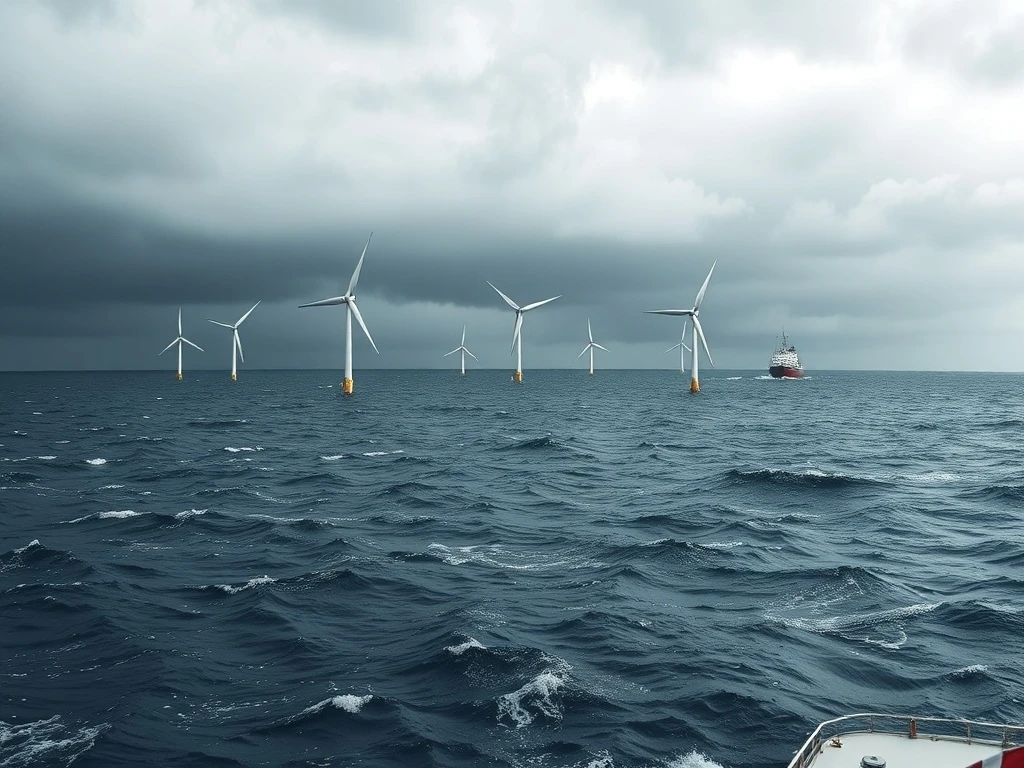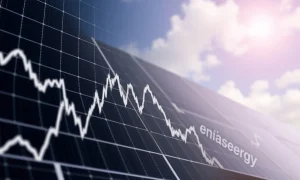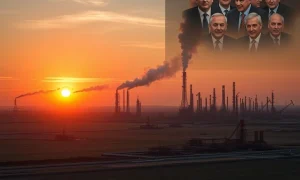Orsted, the Danish energy powerhouse, once placed a monumental bet on the burgeoning U.S. offshore wind market. Indeed, the company aimed to replicate its European success across the Atlantic. However, this ambitious venture encountered severe headwinds, leading to significant financial setbacks. This article explores the dramatic shift in Orsted’s strategy and its implications for the global renewable energy sector, especially concerning the future of Orsted US wind operations.
Orsted US Wind: The Ambitious Entry and Early Promise
Orsted, a global leader in offshore wind development, initially saw immense potential in the United States. Furthermore, the company invested billions into various projects along the East Coast. This strategic expansion aimed to capitalize on growing demand for renewable energy and favorable government policies. For instance, states like New York, New Jersey, and Massachusetts offered significant incentives. These early commitments positioned Orsted as a frontrunner in the nascent American offshore wind industry. Moreover, the company’s extensive experience in Europe promised a smooth transition and rapid development. However, unforeseen economic shifts soon challenged these optimistic projections.
The company secured key leases and began developing large-scale projects. Ocean Wind 1 in New Jersey and Revolution Wind spanning Connecticut and Rhode Island were flagship initiatives. Sunrise Wind, a joint venture with Eversource in New York, also formed a crucial part of their portfolio. Orsted’s initial strategy involved aggressive bidding and rapid deployment. They aimed to establish a dominant market position quickly. This proactive approach seemed logical given the long development cycles inherent in offshore wind. Yet, the global economic landscape began to change rapidly, impacting these plans significantly.
Mounting Headwinds: Inflation and Supply Chain Disruptions
The optimism surrounding Orsted US wind projects began to wane as global economic conditions deteriorated. Firstly, rampant inflation surged across the globe. This significantly increased the cost of materials and labor. Steel, copper, and specialized components became far more expensive. Secondly, supply chain disruptions, a lingering effect of the pandemic, further complicated matters. Essential equipment faced delays, and shipping costs skyrocketed. These factors eroded project profitability at an alarming rate. Consequently, the financial viability of several projects came under intense scrutiny. Orsted faced a difficult choice: absorb the losses or renegotiate contracts.
Rising interest rates compounded these issues. Financing large-scale infrastructure projects became more expensive. Therefore, the cost of capital for Orsted’s massive investments increased substantially. Additionally, the U.S. tax credit system proved less stable than anticipated. Changes and uncertainties surrounding these credits added another layer of risk. These combined economic pressures created a perfect storm for offshore wind developers. Many companies, including Orsted, found their carefully laid plans crumbling. The company soon realized its U.S. ventures required a serious re-evaluation.
Project Cancellations and Significant Impairments
The escalating costs forced Orsted to make tough decisions regarding its U.S. portfolio. In a significant move, the company announced massive impairments on its U.S. offshore wind projects. These write-downs totaled billions of dollars, reflecting the severe impact of the economic headwinds. Specifically, Orsted canceled its Ocean Wind 1 project in New Jersey. This decision alone resulted in a staggering impairment charge. The company cited rising interest rates, supply chain issues, and a lack of sufficient tax credits as primary reasons.
Furthermore, other projects faced significant challenges. Revolution Wind and Sunrise Wind also experienced delays and cost overruns. Orsted attempted to renegotiate power purchase agreements (PPAs) with state utilities. These negotiations aimed to secure higher prices for the electricity generated. However, not all states were willing to agree to the new terms. This situation highlighted the contractual rigidities that often accompany large-scale energy projects. The financial fallout from these U.S. setbacks was substantial. Orsted’s share price plummeted, and investor confidence wavered. This crisis underscored the inherent risks in pioneering new markets, especially when global economic stability is uncertain. The future of Orsted US wind operations became a central concern for the company.
Seeking Solace in Denmark: A Call for State Aid
Faced with mounting losses from its Orsted US wind endeavors, Orsted turned to its home country for assistance. The Danish government, a majority shareholder in Orsted, became a crucial lifeline. Orsted requested state aid and guarantees to mitigate its financial exposure. This move highlighted the strategic importance of Orsted to Denmark’s economy and its green energy ambitions. The Danish state has a vested interest in Orsted’s success, viewing it as a national champion in renewable energy. Therefore, providing support was a logical step to protect a valuable asset and maintain the country’s leadership in green technologies.
Discussions with the Danish government focused on various forms of support. These included potential state guarantees for future projects and direct financial injections. Such interventions are not uncommon for strategically important companies. However, they underscore the severity of the challenges Orsted faced in the U.S. market. The reliance on state backing also raises questions about the pure commercial viability of offshore wind projects under current economic conditions. Denmark’s willingness to step in demonstrates a strong commitment to its green transition goals, even when faced with international market difficulties. This support provides a crucial safety net for Orsted as it navigates its U.S. challenges.
Broader Implications for the Offshore Wind Industry
Orsted’s struggles in the U.S. have sent ripples throughout the global offshore wind industry. Firstly, they serve as a stark warning about the impact of inflation and supply chain vulnerabilities. Developers worldwide are now re-evaluating their risk assessments. Secondly, the challenges highlight the need for more flexible contractual frameworks. Fixed-price power purchase agreements, while offering certainty, can become crippling during periods of high inflation. Thirdly, the incident underscores the importance of robust government support and clear policy signals. Stable tax incentives and streamlined permitting processes are vital for attracting and retaining investment.
Several other developers have also reported difficulties. BP and Equinor, for instance, took significant impairments on their U.S. projects. Shell also withdrew from a U.S. offshore wind project. These collective setbacks suggest systemic issues rather than isolated incidents. The industry must adapt to a new economic reality. This includes innovating construction methods, optimizing supply chains, and fostering stronger collaboration between developers and governments. The future growth of offshore wind, a critical component of global decarbonization efforts, depends on learning from these experiences. The performance of Orsted US wind operations will be a key indicator for others.
The Path Forward for Orsted and US Offshore Wind
Despite the recent setbacks, Orsted remains committed to the U.S. offshore wind market, albeit with a more cautious approach. The company continues to develop its remaining projects, such as Revolution Wind and the revised Sunrise Wind. These projects are moving forward with renegotiated terms or revised strategies. Orsted plans to focus on project execution and cost control more rigorously. The experience has prompted a re-evaluation of its risk management strategies. The company aims to de-risk future investments by securing more favorable contract terms and hedging against economic fluctuations.
For the U.S. offshore wind industry, Orsted’s experience offers valuable lessons. Policymakers are now considering adjustments to existing frameworks. These include indexing PPA prices to inflation and offering more robust federal support. The long-term potential for offshore wind in the U.S. remains strong. Its vast coastline and shallow waters offer significant renewable energy resources. However, achieving this potential requires a collaborative effort from industry, government, and financial institutions. Learning from the challenges faced by Orsted US wind is essential for building a resilient and sustainable offshore wind sector in America.
Frequently Asked Questions (FAQs)
What caused Orsted’s financial difficulties in the U.S. offshore wind market?
Orsted’s financial difficulties stemmed primarily from soaring inflation, rising interest rates, and significant supply chain disruptions. These factors drastically increased project costs, eroding profitability. Additionally, uncertainties surrounding U.S. tax credits contributed to the challenges.
Which specific U.S. projects did Orsted cancel or delay?
Orsted notably canceled its Ocean Wind 1 project in New Jersey. Other projects, like Revolution Wind and Sunrise Wind, faced delays and required renegotiations due to the escalating costs.
How is the Danish government assisting Orsted?
The Danish government, a majority shareholder in Orsted, is providing financial support. This includes discussions around state guarantees for future projects and potential direct financial aid to help Orsted mitigate its U.S. losses.
What are the broader implications of Orsted’s struggles for the offshore wind industry?
Orsted’s challenges serve as a warning to the entire industry about inflation and supply chain risks. They highlight the need for more flexible contracts and robust, stable government policies to support large-scale renewable energy projects globally.
Is Orsted completely withdrawing from the U.S. offshore wind market?
No, Orsted is not completely withdrawing. While it has scaled back some ambitions and taken impairments, the company remains committed to its operational and renegotiated projects in the U.S., albeit with a more cautious and de-risked approach moving forward.
What lessons can the U.S. offshore wind industry learn from Orsted’s experience?
The U.S. industry can learn the importance of flexible power purchase agreements, stable and predictable federal support, and resilient supply chains. Adapting to economic volatility and fostering stronger collaboration are crucial for long-term success.
























